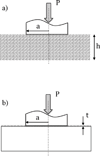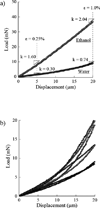On the stiffness of demineralized dentin matrices
- PMID: 26747822
- PMCID: PMC4747863
- DOI: 10.1016/j.dental.2015.11.029
On the stiffness of demineralized dentin matrices
Abstract
Resin bonding to dentin requires the use of self-etching primers or acid etching to decalcify the surface and expose a layer of collagen fibrils of the dentin matrix. Acid-etching reduces the stiffness of demineralized dentin from approximately 19 GPa-1 MPa, requiring that it floats in water to prevent it from collapsing during bonding procedures. Several publications show that crosslinking agents like gluteraladehyde, carbodiimide or grape seed extract can stiffen collagen and improve resin-dentin bond strength.
Objective: The objective was to assess a new approach for evaluating the changes in stiffness of decalcified dentin by polar solvents and a collagen cross-linker.
Methods: Fully demineralized dentin beams and sections of etched coronal dentin were subjected to indentation loading using a cylindrical flat indenter in water, and after treatment with ethanol or ethyl-3-(3-dimethylaminopropyl) carbodiimide (EDC). The stiffness was measured as a function of strain and as a function of loading rate from 1 to 50 μm/s.
Results: At a strain of 0.25% the elastic modulus of the fully demineralized dentin was approximately 0.20 MPa. It increased to over 0.90 MPa at strains of 1%. Exposure to ethanol caused an increase in elastic modulus of up to four times. Increasing the loading rate from 1 to 50 μm/s caused an increase in the apparent modulus of up to three times in both water and ethanol. EDC treatment caused increases in the stiffness in fully demineralized samples and in acid-etched demineralized dentin surfaces in situ.
Significance: Changes in the mechanical behavior of demineralized collagen matrices can be measured effectively under hydration via indentation with cylindrical flat indenters. This approach can be used for quantifying the effects of bonding treatments on the properties of decalcified dentin after acid etching, as well as to follow the loss of stiffness over time due to enzymatic degradation.
Keywords: Collagen; Crosslinking; Dentin bonding agents; Durability; EDC; Endogenous proteinases; Stiffness.
Copyright © 2015 Academy of Dental Materials. Published by Elsevier Ltd. All rights reserved.
Figures







References
-
- Yiu CKY, Pashley EL, Hirashi N, King NM, Goracci C, Ferrari M, Carvalho RM, Pashley DH, Tay FR. Solvent and water retention in dental adhesive blends after evaporation. Biomaterials. 2005;26:6863–6872. - PubMed
-
- Spencer P, Wang Y, Walker MP, Wieliczka DM, Swafford JR. Interfacial chemistry of the dentin/adhesive bond. J Dent Res. 2000;79(7):1458–1463. - PubMed
-
- Tjäderhane L, Nascimento FD, Breschi L, Mazzoni A, Tersariol IL, Geraldeli S, Tezvergil-Mutluay A, Carrilho MR, Carvalho RM, Tay FR, Pashley DH. Optimizing dentin bond durability: control of collagen degradation by matrix metalloproteinases and cysteine cathepsins. Dent Mater. 2013;29(1):116–135. - PMC - PubMed
Publication types
MeSH terms
Substances
Grants and funding
LinkOut - more resources
Full Text Sources
Other Literature Sources

